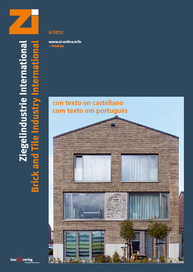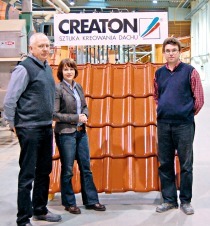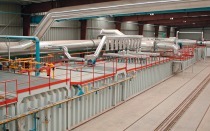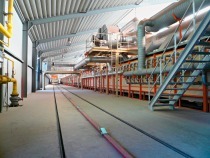Ceric Technologies designs a supersized tunnel kiln for a Polish roofing tile plant
For its new Koscian facility, which will produce 30 mill. large-size clay roofing tiles (10 tiles/m2) and related accessories, the Belgian Etex Group has decided to entrust Ceric Technologies with the design of its kiln. Measuring 220 m in length and 10.28 m in width, the kiln is exceptionally large, but key features of this new project of the ceramics manufacturing equipment specialist are its performance and innovative elements.
The Casing tunnel kiln with a sand seal is equipped with all Ceric Technologies’ latest innovations. Once complete, it is set to be the largest kiln in the world for the firing of tiles on H-setters. Around 750 panels were cast in the workshops of Ceric Technologies and shipped to Poland. Given the large dimensions of the kiln, the mechanical strength of the panels was the subject of extensive modelling calculations to ensure their stability, especially in the assembly phase.
On average, 38 cars per day will be pushed through the kiln, in which tiles and accessories will be simultaneously fired to ensure colour consistency and optimum energy utilization. The average firing cycle lasts 21 hours at just over 1 000° C. Cars with an individual loading area of 60 m2 are equipped with lightweight refractories for better thermal efficiency. Perlite is used to insulate the kiln walls while expanded clay is used for the car floor.
“With a kiln width of more than 10 m, it was necessary to improve temperature uniformity and air circulation efficiency”, says Lionel Dumont, Manager of the Process Engineering Department at Ceric Technologies. For this reason, the equipment supplier chose to distribute 338 low-power unitary burners in the high firing area to ensure homogeneous firing. High-speed burners are installed for preheating in the kiln roof, but not on the kiln walls as is often the case. In the pre-heating and cooling zones, patented Thermobooster circulation systems are integrated into the roof. The Koscian kiln is the first roofing tile kiln in Europe to be equipped with this system. It lowers the number of burners and improves the kiln’s energy performance. The air circulation in the pre-heating area enables a reduction in the consumption of energy while ensuring regular and improved heat exchange in the cooling zone. To minimize energy consumption, the fans are powered with variable speed drives.
Ceric Technologies’ new computerized Diapason control system will ensure permanent monitoring of the kiln as well as mapping of the kiln cars and provide a clear real-time image of energy transfers between the kiln and the dryer. Ceric Technologies has developed the best solution to best capitalize on the exceptional size of this kiln.






